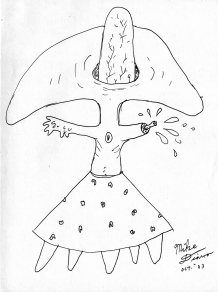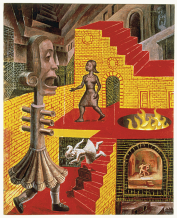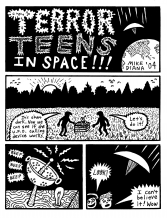| Revista Umělec 2007/1 >> Simplement Compliqué | Lista de todas las ediciones | ||||||||||||
|
|||||||||||||
Simplement CompliquéRevista Umělec 2007/101.01.2007 Leonor Nuridsany | Teoría | en cs de |
|||||||||||||
|
The FRACs are “simply complicated” as Thomas Bernard would say. But let us try to be simple at the outset: The initials, F.R.A.C., stand for Fonds Régionaux d‘Art Contemporain—the French regional funds for contemporary art. In other words, each region is charged with establishing, with the assistance of the French state and the French regions, a collection of contemporary art, and is responsible for preserving and circulating the works in France and abroad.
In practice, a purchase committee meets once per year to consider new acquisitions. This is composed of the director of the FRAC and of four to six members knowledgeable on issues associated with art, appointed for a three year term that is renewable by the regional council at the proposal of the director of the FRAC upon consultations around the region. A recent study counted about 17,000 works among 23 FRACs including some 3700 artists, forty percent of whom are foreigners. Up until recently, the annual budget for acquisition and operation of any FRAC has been divided evenly with fifty percent of the funds from the State and fifty percent from the region. For the last few years, the balance of finance has tilted from the state towards the regions with an expansion of private marketing partners. A tendency that is reaffirmed each year, as a result of the politics of growing decentralization. To better understand the function of this very typically French institution, let us go back to the time its incipience. In 1982, under the new presidency of François Mitterand, the State had hoped the FRACs would animate the art market artificially. The market was something practically non-existant at the time. In trying to persuade collectors to buy in France, the FRACs would exculsively purchase works from French galleries. A market did effectively develop, and so did a number of new galleries that recognized an opportunity to easily sell. Unfortunately, few of them knew of, or even wanted to take advantage of a developing resource, and most were satisfied with the purchases from the State. Both foreign galleries and French galleries became caught up in that. Today, the function has slightly relaxed since the FRACs, even though they continue to favor galleries, have begun working directly with artists who aren’t represented by any gallery. On the other hand, there continues to be a desire to establish a framework with the help of contemporary acquisitions. To be sure, the interest is based on investment potential, but the reasons date back to the 19th century, to the time when France allowed a lot of Impressionist paintings to be passed abroad. That’s a moment of great trauma for the French state, which has never forgotten. Today, notably the FRACs, the state and the regions really do have works that have become historic. The Boîte en valise of Marcel Duchamp, acquired in 1988 by the Poitou Charente FRAC is a case in point. There were also the avant-gardes of the 1960s, Arte Povera, Minimal art, and conceptual works purchased at a time when such types of work were still financially affordable and relatively rarely displayed in French museums. In the 1990s, some of the FRACs sought to build—with all apparent risks and necessities associated—a history of the present. Indeed, the past, even the recent past, has become increasingly the subject of museums. We should also be clear that the FRACs embody an aspect of France’s 1982 decentralization laws. One of the FRACs’s missions was to locate international collections in France's regions. Certain FRACs, such as that of the Loire, have rapidly established artistic residencies. Today, the majority are engaged with the production of works, often associated with the specicity of the politics of the acquisitions. For example, the Nord-Pas-de-Calais FRAC is distinguished by links it established with design. The Centre FRAC places a stronger accent on art and architecture. The Alsace FRAC is art for public space, the countryside and landscape, whereas immaterial, ephemeral and feminist artists are the preoccupation of Lorraine FRAC. The Lorraine FRAC is one of the five FRACs that participated in the initiative of the “Naturalia” exhibition at Prague’s Futura gallery and at the French Institute of Prague (November, 2005). The FRACs of Alsace, Bourgogne, Champagne Ardenne, Franche-Compté, and Lorraine are aligned as the “Frac du Grand Est” in order to define a project to circulate their respective collections throughout Europe. Entitled “Collections sans frontières,” the project involves inviting directors of European institutions to create their own exhibitions working with art from these five FRACs. This is not for any single traveling show, but of a “carte blanche” offered to each institution's director. They are free to realize an exhibition that functions in any particular manner, the origin of works—in occurrence of an international French collection—one can observe that this is not always the case. “Naturalia” in Prague was the fifth exhibition among the “Collections sans frontières.” The first was organized in collaboration with the Gallery of Modern Art at the Promotrice in Turin, Italy, in 2003. The second, the same year, was at the Zacheta Gallery in Warsaw, Poland. In 2004, two centers of art in Scotland acquired the exhibition: the Dundee Contemporary Arts Center, and the Fruitmarket Gallery in Edinburgh. The Jan Koniarek gallery in Trnava, Slovakia, organized the fifth in 2005. We have noted new initiatives that were associated with the exhibition in Prague. One of the artists whose works are at the FRAC Chamagne-Ardenne collection, David Renaud, was invited for a one month residency at Futura’s associated Trebesice castle in order to realize a work on location. Renaud’s work became part of the Futura collection. Future residencies in Prague and France were being seriously considered. Another news item: three Czech artists, David Černý, Tomáš Vaněk and the Italian, Caterina Notte, were invited to present their work at Futura and at the Třebešice castle. Another news item: a series of coloquiums organized by the Tranzit association in Prague on the theme of the production of art works with art centers in France and in the Czech Republic. These initiatives certainly result from the initiative and dynamic on the part of the French more than by the Czechs, but it probably also results from the 2001 agreement of cooperation between the Bourgogne capital Dijon and Bohemia. These politic-economic aliances brought two regions together, representing a promise of new projects in the future... For this fifth FRAC show, Alberto Di Stefano, director of the exhibition and Futura, had selected the theme of the exhibition before having seen the FRAC collections in France. This allowed him to approach the theme of perception and the representation of nature today, a rich subject that could not be so approached if he’d not been given access to five different collections. And just out of interest: in addition to the distribution of collections, the productions, the residences that have been or will come, and the exchanges that result from encounters among participants of the Czech artistic scene, there is also the question of offering these collections a new visibility. Collections that were constituted more than 20 years ago by different directors bring to the course of their mandates a personal approach to the heart of state institutions. Looking at this from a different point of view, that of the director of an independent space (Futura), a first for FRACS that have been, until now, directed towards institutions. These are points that demonstrate that a collection is not immutable. And the particulars of five collections, or whether they will be enriched by Czech aquisitions? The future will tell.
01.01.2007
Artículos recomendados
|
|||||||||||||
|
04.02.2020 10:17
Letošní 50. ročník Art Basel přilákal celkem 93 000 návštěvníků a sběratelů z 80 zemí světa. 290 prémiových galerií představilo umělecká díla od počátku 20. století až po současnost. Hlavní sektor přehlídky, tradičně v prvním patře výstavního prostoru, představil 232 předních galerií z celého světa nabízející umění nejvyšší kvality. Veletrh ukázal vzestupný trend prodeje prostřednictvím galerií jak soukromým sbírkám, tak i institucím. Kromě hlavního veletrhu stály za návštěvu i ty přidružené: Volta, Liste a Photo Basel, k tomu doprovodné programy a výstavy v místních institucích, které kvalitou daleko přesahují hranice města tj. Kunsthalle Basel, Kunstmuseum, Tinguely muzeum nebo Fondation Beyeler.
|


































 We Are Rising National Gallery For You! Go to Kyjov by Krásná Lípa no.37.
We Are Rising National Gallery For You! Go to Kyjov by Krásná Lípa no.37.
Comentarios
Actualmente no hay comentariosAgregar nuevo comentario